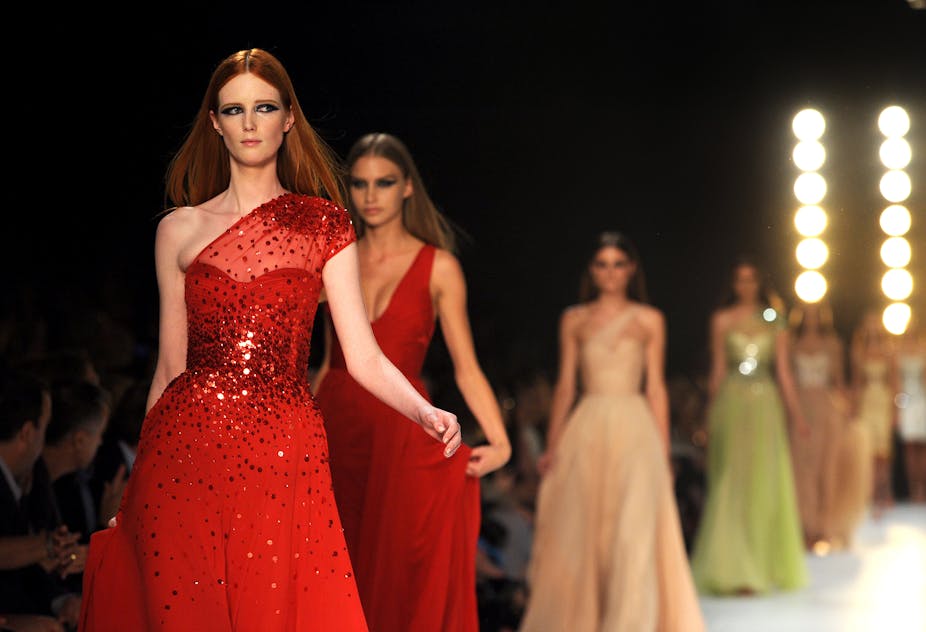The first of the yearly “fashion weeks” has just ended in Melbourne. Along with the glamour and excitement, the models were out in force showcasing the latest fashion to the undivided attention of the media.
Marketers and social scientists know the effects of marketing extends beyond product awareness to impact audience beliefs, values, attitudes, and behaviours. These beliefs are susceptible to outside influences including marketing and media messages. And models play a strong role in these messages as beyond their role on catwalks, they are a key element in marketing.
The latest definition of marketing by the American Marketing Association states that it should not cause harm to society. But research has found evidence that attractive models used in advertising represent unrealistic ideals and cause harm through such things as misperceptions of one’s appearance.
My research found that both men and women’s self-esteem decreased after they were exposed to images of male and female models. And other studies have found that decreased self-esteem can lead to shape and weight dissatisfaction and disordered eating.
The ideal dictated by models in marketing imagery is homogenous – Caucasian with slim physiques – and it’s imposed on a heterogeneous audience. With only 5% of the world’s population able to achieve this type of appearance, many people are left feeling inadequate.
Body image dissatisfaction is increasingly recognised as an important target for public health action. Research evidence links body image dissatisfaction to physical and mental health concerns. The disturbance in perception of body shape is also an essential feature of eating disorders.
Studies in the social sciences have found that people suffer severely from the thought that they are physically unattractive. And the notion that perceptions of beauty are largely shared must aggravate such worries; hopefully, the idea of beauty being predominantly in the eye of the beholder must alleviate them.
Concern with appearance is not just a reflection of modern western culture. Every period of history has had its own standards of what is and isn’t beautiful, and every contemporary society has its own distinctive concept of ideal physical attributes.
In sharp contrast to today’s emphasis on health and vigour, in the mid-1800s it was fashionable to be pale and delicate (ill by today’s standards). And today’s angular and lean standards are in stark contrast to the voluptuous and curved body shapes from the 1950s.
Despite the “thin ideal”, the average weight of real women has increased thus widening the gap between cultural norms and biological realities.
Images of men in marketing, on the other hand, have grown more muscular. The idealised male body image is now defined as a hyper masculine, young body. These ideals highlight the discrepancy between media representations and the body image of most males.
Although we resemble our ancestors and other cultures in our concern about appearance, there’s an important difference in degree of this concern. Advances in technology and, in particular, the rise of the mass media, has changed normal concerns about how people look into obsessions.
The mass media convey unmistakable images of the “body beautiful,” coupled with thinly-veiled admonitions to conform to this ideal. Such ideals are arbitrary products of culture but people strive to attain them with diet, exercise, makeup, hairstyle, clothing, and even cosmetic surgery, because to ignore the consensual standards of physical attractiveness is to disengage from society.
Exposure to television, billboards, the internet and magazines means that consumers see “beautiful people” all the time, making exceptionally good looks seem real, normal and attainable.
If thinness for women and a lean and muscular body for men are prevailing sociocultural standards of beauty and if the mass media portray only this cultural ideal, it may not be possible to reject such images. When many others believe it, it is presumed to be true.
Most advertisements contain models whose faces have obviously been airbrushed in the attempt to represent an exclusively youthful beauty, as if a more aged face necessarily is a decline in beauty. As a consequence, a plethora of services and facial products have emerged in the market to satisfy the demand to hold back the ravages of time.
A consumer backlash has shown a preference for authentic images, and one example of an attempt at an “authentic” campaign is the Dove campaign using “real women” to represent beauty.
A superficial understanding of beauty is detrimental to people and the culture in which they live. If marketing used models consistent with messages for healthy lifestyles, representative body shapes and sizes, it would result in social integration that would resonate with changing community expectations.

